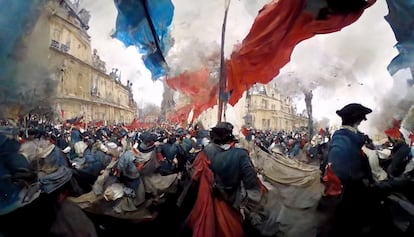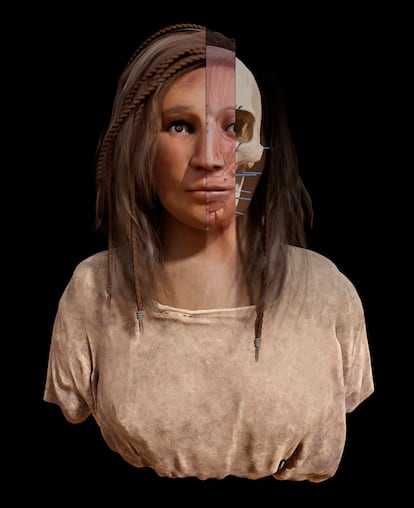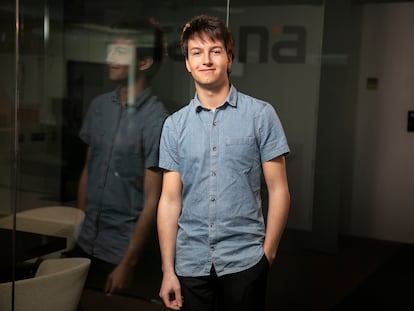Resurrected mummies and ancient cities: The problem with AI-generated images
Archaeologists and historians warn of the risks of the artificial reconstruction of heritage for cultural knowledge

Recent tweets of images depicting “reconstructions of historical figures,” such as the face of a Guanche mummy generated by an artificial intelligence (AI) application, have stirred up a new controversy. So much so that the tweeter reposted the image with a caveat that it was an “unreliable” reconstruction. He had used Midjourney, one of the AI applications that can create images from text prompts. Archaeologists and historians raised a red flag, warning of the risks to cultural heritage posed by these AI-generated images, including historical fakes, shortcutting the scientific process, stereotype reinforcement and copyright disputes.
How to make forensically NOT reliable facial reconstructions with #midjourney.
— Javi Lopez ⛩️ (@javilopen) January 15, 2023
I will explain you in detail the easy process and all the prompts used in my most controversial thread of 2023 (so far) so you can experiment too.
Here it goes 🧵👇 pic.twitter.com/YfV45BB9HU
Pablo Aparicio is cofounder of 3D Stoa, a company that creates virtual reconstructions of cultural heritage. He says their work combines historical knowledge and anthropology with various documentation techniques to accurately reconstruct architectural assets, artwork and archaeological sites. A single project can take several months of effort by multiple people.
For example, Aparicio says the first step to reconstructing a castle is a laser scan or digital photogrammetry of the ruins. Using this “perfect geometric foundation,” the architectural projection of the castle is built up using computer programs like Blender and other 3D-rendering software. “We develop hypotheses with architects and archaeologists who guide us through every step. We show them interim results, and they tell us whether the walls should be higher or lower, whether it should look different and where a roof is needed. They give us the details we need to move forward,” said Aparicio. “It’s a very precise job, and we always incorporate the changes requested by the experts who commissioned the work.”
Aparicio says the first problem of reconstructions made with generative AI is the lack of precision. “No matter how good or well-written your prompt [command] to design a certain type of castle, it’s impossible to give it [the application] all the details needed to make it a precise rendering.” The AI-generated images are often eye-catching and work very well on social media. Despite the pretty picture, it’s a false representation with enough verisimilitude to cause confusion. “They deliver an image that looks real or could be real. And therein lies the biggest problem. It promotes unscientific historical fakes on social media that appear real or true,” said Aparicio.
The blender effect
The very nature of generative AI technology is the root cause of the problem. These applications train on unknown data sets and work like a blender to produce a puree of everything available online. “Artificial intelligence pulls from the most widely available sources, so the image it produces of the Roman Colosseum will not be a complete reconstruction of what it looked like in antiquity, but rather the arena in ruins, as it is today. This is totally wrong,” said Aparicio.

Alberto Venegas, a professor of history at the University of Murcia (Spain), says that since the primary function of these tools is recombination, they reaffirm stereotypes and perpetuate erroneous ideas about the past. “The images are not even remotely similar to the past. They are a massive combination of every image found, regardless of source, purpose or creator. It perpetuates common myths and images that we are used to seeing in the media,” he said.
For example, Venegas cites the “impressive representation” of Paris during the French Revolution from the perspective of a GoPro camera that circulated widely on social media. Any historian would see that the Paris in those images is not from the revolutionary period, says Venegas, but from a mix of the French Second Empire and Third Republic periods. However, in the collective imagination are Parisian elements like slate roofs, chimneys, large doorways, stone buildings and grand avenues. “Paris in the 18th century was not like that. That came later after several city renovation projects. Similarly, the image depicts the modern French flag, not the one used at the time.”
“The AI program has assembled every plausible element that makes us think of the French Revolution because we’ve seen it on television, in video games and in movies. I call it media history and aesthetic memory because it evokes an inaccurate image of that time,” said Venegas.
Could AI be used to reconstruct a plausible image of cultural heritage? Venegas thinks so. “If you feed the right data to the program, it could come close to the reconstructions that experts do,” he said. The professor recalled the “The Next Rembrandt” project by Dutch designer Bas Korsten with the Delft University of Technology (Netherlands) and the Rembrandthuis Museum. The project collected 170,000 images of the Dutch painter Rembrandt’s work and used this database to generate a near-perfect work of art replicating the artist’s distinctive style and brushstroke.
Intelligent reconstruction also raises copyright issues since it appropriates the work of thousands of photographers, illustrators, designers and artists. These tools remain unregulated while the debate about plagiarism and copyright infringement rages.
Although Venegas and Aparicio are critical of using these tools for a complete reconstruction of cultural heritage, they agree that they are helpful for small parts of the traditional process, such as choosing surface textures and other finishes. Venegas says they may be beneficial in educational settings. “Schools and universities could use them in activities like reflection, criticism and discussions of various images from different periods. These are positive uses for the educational process.”
Sign up for our weekly newsletter to get more English-language news coverage from EL PAÍS USA Edition
Tu suscripción se está usando en otro dispositivo
¿Quieres añadir otro usuario a tu suscripción?
Si continúas leyendo en este dispositivo, no se podrá leer en el otro.
FlechaTu suscripción se está usando en otro dispositivo y solo puedes acceder a EL PAÍS desde un dispositivo a la vez.
Si quieres compartir tu cuenta, cambia tu suscripción a la modalidad Premium, así podrás añadir otro usuario. Cada uno accederá con su propia cuenta de email, lo que os permitirá personalizar vuestra experiencia en EL PAÍS.
¿Tienes una suscripción de empresa? Accede aquí para contratar más cuentas.
En el caso de no saber quién está usando tu cuenta, te recomendamos cambiar tu contraseña aquí.
Si decides continuar compartiendo tu cuenta, este mensaje se mostrará en tu dispositivo y en el de la otra persona que está usando tu cuenta de forma indefinida, afectando a tu experiencia de lectura. Puedes consultar aquí los términos y condiciones de la suscripción digital.











































